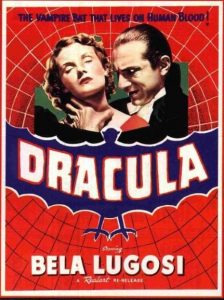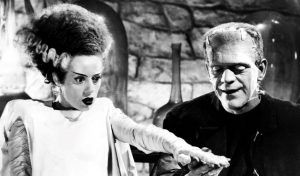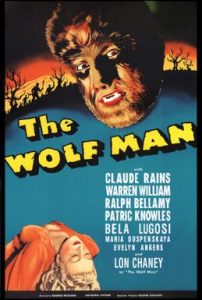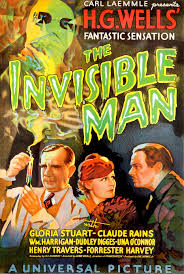 No CGI in the classic horror movies of yore, but they could still scare the crap out of you. Here are some memorable lines from a few of them.
No CGI in the classic horror movies of yore, but they could still scare the crap out of you. Here are some memorable lines from a few of them.
“My, what a big bat!” Yes, quite large. John Harker (David Manners) uttered this line in the 1931 version of Dracula.
One more from this memorable film. Count Dracula (Bela Lugosi) upon hearing wolves howling: “Listen to them. Children of the night. What music they make.”
Henry Frankenstein (Colin Clive) from another 1931 classic, Frankenstein: “The brain you stole, Fritz. Think of it. The brain of a dead man waiting to live again in a body I made with my own hands! With my own hands!”
One more from Dr. Frankenstein, and apologies for not being able to resist: “Look, it’s moving. It’s alive! It’s alive! It’s moving, it’s alive, it’s alive, it’s alive, it’s alive, IT’S ALIVE!”

Elsa Lanchester and Boris Karloff in Bride of Frankenstein.
In the 1935 film, Bride of Frankenstein, Dr. Pretorius (Ernest Thesiger) tells Henry Frankenstein (Colin Clive again): “”Our mad dream is only half realized. Alone, you have created the man. Now, together, we will create—his mate.” When Frankenstein asks him what he means, Pretorius says, “Yes, a woman. That should be really interesting.”
In the same film, Dr. Pretorius asks the Monster (Boris Karloff) if he knows who Dr. Frankenstein is: “Yes, I know. Made me from dead. I love dead…hate living.” Rather sad, no?
“Save me from that mummy! It’s dead!” Helen Grosvenor (Zita Johann) in the 1932 version of The Mummy.
Same film, Dr. Muller (Edward Van Sloan) appears to agree: “Put it back. Bury it where you found it! You have read the curse. You dare defy it?”
 In the 1941 classic, The Wolf Man, Larry Talbot (Lon Chaney, Jr.) has killed a werewolf—the son of the gypsy woman, Maleva—but is bitten in the process…and we all know what that means. Maleva tells him, “Whoever is bitten by a werewolf and lives becomes a werewolf himself.”
In the 1941 classic, The Wolf Man, Larry Talbot (Lon Chaney, Jr.) has killed a werewolf—the son of the gypsy woman, Maleva—but is bitten in the process…and we all know what that means. Maleva tells him, “Whoever is bitten by a werewolf and lives becomes a werewolf himself.”
Just about everyone in this film utters the following line: “Even a man who is pure in heart and says his prayers by night, may become a wolf when the wolfbane blooms and the autumn moon is bright.”
In the 1925 silent film, The Phantom of the Opera, the “dialogue” is shown on title cards. The storyline is pretty much what you’d be familiar with if you’ve seen Andrew Lloyd Webber’s musical version. (I have…eight times.) Lon Chaney (the elder) scared the crap out of filmgoers with his creepy makeup. He is enamored of singer Christine Daaé (Mary Philbin) and tells her, “If I am the Phantom, it is because man’s hatred has made me so. If I shall be saved, it will be because your love redeems me.”

Lon Chaney as The Phantom of the Opera.
A character named Joseph Buquet offers this lurid description of the Phantom: “His eyes are ghastly beads in which there is no light…like holes in a grinning skull. His face is like leprous parchment, yellow skin strung tight over protruding bones! His nose…there is no nose!”
“Poole, there’s a friend of mine named Hyde. I want him to have full liberty and authority about the house.” Dr. Henry Jekyll (John Barrymore) in another silent classic from 1920, Dr. Jekyll and Mr. Hyde.
In The Invisible Man (1933) starring Claude Rains, scientist Jack Griffin has created a formula to render himself invisible, which also turns him into a bit of a nutter. “An invisible man can rule the world. Nobody will see him come, nobody will see him go. He can hear every secret. He can rob, and wreck, and kill!”
And it only gets worse: “We’ll begin with a reign of terror, a few murders here and there, murders of great men, murders of little men…well, just to show we make no distinction. I might even wreck a train or two…just these fingers around a signalman’s throat, that’s all.”
 Finally, one of the dumbest jokes ever—but I love it. Igor tells Dr. Frankenstein, “Master, the Invisible Man is here!” The doc’s reply: “Tell him I can’t see him.” Sorry…not! 😊
Finally, one of the dumbest jokes ever—but I love it. Igor tells Dr. Frankenstein, “Master, the Invisible Man is here!” The doc’s reply: “Tell him I can’t see him.” Sorry…not! 😊
